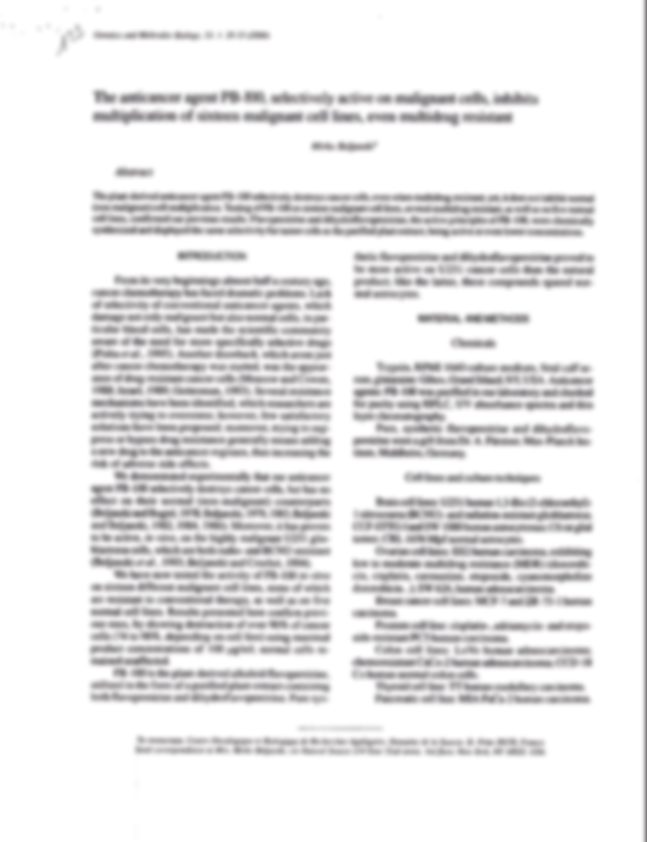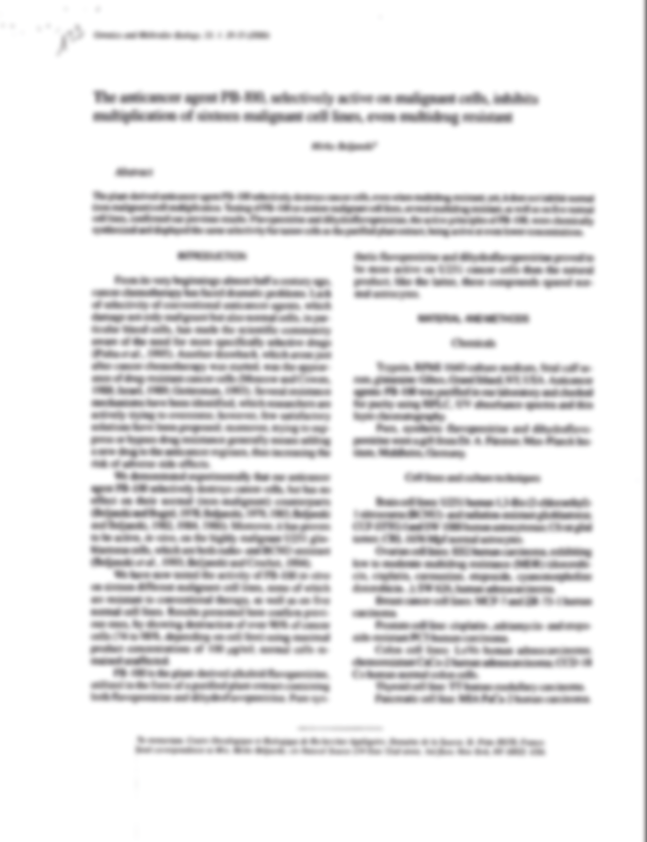110 – Differential Synthesis and Replication of DNA in the Neurospora crassa Slime Mutant versus Normal Cells: Role of Carcinogens
Oncology, 44, 1987, pp. 327-330
Available in English only
ABSTRACT: Small quantities of carcinogens, dl-ethionine, thiotepa, actinomycin D, and 1-(2-chloroethyl-3-cyclohexyl)-1-nitrosourea (CCNU) stimulated in vitro deoxyribonucleic acid (DNA) synthesis of the slime mutant of Neurospora crassa, while there was practically no effect on the DNA from the normal wild type 74A strain. All of these compounds caused increased strand separation in the mutant DNA of N. crassa, but no separation of normal DNA strands. The growth (in vivo tests) of the N. crassa slime mutant, but not its wild type, was markedly increased when nontoxic concentrations of one of the carcinogens (dl-ethionine) tested were present in the growth medium. These observations suggest that, unlike the wild type N. crassa, the slime mutant allows an excessive and unscheduled replication, indicating destabilized nature of its DNA.
ABSTRACT: Small quantities of carcinogens, dl-ethionine, thiotepa, actinomycin D, and 1-(2-chloroethyl-3-cyclohexyl)-1-nitrosourea (CCNU) stimulated in vitro deoxyribonucleic acid (DNA) synthesis of the slime mutant of Neurospora crassa, while there was practically no effect on the DNA from the normal wild type 74A strain. All of these compounds caused increased strand separation in the mutant DNA of N. crassa, but no separation of normal DNA strands. The growth (in vivo tests) of the N. crassa slime mutant, but not its wild type, was markedly increased when nontoxic concentrations of one of the carcinogens (dl-ethionine) tested were present in the growth medium. These observations suggest that, unlike the wild type N. crassa, the slime mutant allows an excessive and unscheduled replication, indicating destabilized nature of its DNA.
109 – Terminal deoxynucleotidyl transferase and ribonuclease activities in purified hepatitis-B antigen
Med. Sci. Res., 15, 1987, pp. 529-530.
Available in English only
ABSTRACT: Terminal deoxyribonucleotidyl transferase (TdT) (EC 2.7.7.31) was defined as a template independent DNA polymerase that binds deoxyribonucleoside-5′-monophosphates (dNMP) in sequential addition to the 3’OH end of the DNA initiator. TdT may exhibit its activity in the presence of oligodeoxyribopolymers. This enzyme has been found in embryonic calf thymus gland, cortical thymocytes, brain, primitive bone marrow cells, peripheral blood lymphocytes in certain forms of acute leukemia, neuroblastoma and retroviruses. A model was proposed according to which TdT may generate somatic mutations in the variable region of immunoglobulin genes. Recently, the mutagenic potential of TdT has been evaluated: TdT inserts noncomplementary bases during repair synthesis by DNA polymerase. The present work shows that purified and commercially available hepatitis-B antigen (vaccine) contains a very active TdT and ribonuclease (RNase).
ABSTRACT: Terminal deoxyribonucleotidyl transferase (TdT) (EC 2.7.7.31) was defined as a template independent DNA polymerase that binds deoxyribonucleoside-5′-monophosphates (dNMP) in sequential addition to the 3’OH end of the DNA initiator. TdT may exhibit its activity in the presence of oligodeoxyribopolymers. This enzyme has been found in embryonic calf thymus gland, cortical thymocytes, brain, primitive bone marrow cells, peripheral blood lymphocytes in certain forms of acute leukemia, neuroblastoma and retroviruses. A model was proposed according to which TdT may generate somatic mutations in the variable region of immunoglobulin genes. Recently, the mutagenic potential of TdT has been evaluated: TdT inserts noncomplementary bases during repair synthesis by DNA polymerase. The present work shows that purified and commercially available hepatitis-B antigen (vaccine) contains a very active TdT and ribonuclease (RNase).
108 – Régulation des gènes, cancer et prévention
Médecines nouvelles, 15, 1986, pp. 57-86.
Document not available online.
Document not available online.
107 – Possible role of markers synthesized during cancer evolution: II- Markers in crown-gall tissues
IRCS Med. Sci. 14, 1986, pp. 811-812
Document not available online
Document not available online
106 – Possible role of markers synthesized during cancer evolution: I- Markers in mammalian tissues
IRCS Med. Sci. 14, 1986, pp. 809-810.
Available in English only
ABSTRACT: Various trigger molecules (carcinogens, antimitotics, antibiotics, hormones, etc…) may induce mammalian cancer DNA chain relaxation correlated with an in vitro increase of DNA synthesis and the enhancement of cancer cell multiplication in vivo. In contrast, particular substances which contract cancer DNA chains inhibit cancer DNA synthesis and prevent cancer cell multiplication in vivo. During cancer evolution, large amounts of α-feto-protein (AFP), carcinoembryonic antigen (CEA) and calcitonin, may be synthesized. AFP normally produced by liver cells may accumulate in breast cancer tissues or in induced inflammatory lesions; it favours the accumulation of estrone in the new-born rat brain and affects the multiplication of estrogen-sensitive cells. The aim of the present work was to determine the effect of some embryonic antigens (markers) on normal and cancer DNA chain relaxation and DNA in vitro synthesis, in order to investigate their participation in the maintenance of the neoplastic state in vivo.
ABSTRACT: Various trigger molecules (carcinogens, antimitotics, antibiotics, hormones, etc…) may induce mammalian cancer DNA chain relaxation correlated with an in vitro increase of DNA synthesis and the enhancement of cancer cell multiplication in vivo. In contrast, particular substances which contract cancer DNA chains inhibit cancer DNA synthesis and prevent cancer cell multiplication in vivo. During cancer evolution, large amounts of α-feto-protein (AFP), carcinoembryonic antigen (CEA) and calcitonin, may be synthesized. AFP normally produced by liver cells may accumulate in breast cancer tissues or in induced inflammatory lesions; it favours the accumulation of estrone in the new-born rat brain and affects the multiplication of estrogen-sensitive cells. The aim of the present work was to determine the effect of some embryonic antigens (markers) on normal and cancer DNA chain relaxation and DNA in vitro synthesis, in order to investigate their participation in the maintenance of the neoplastic state in vivo.
105 – Analysis of small RNA species: phylogenetic trends
In DNA Systematics, vol.I: Evolution. Ed. S.K. Dutta CRC Press, Inc. Florida (1986), pp. 81-105.
Document not available online
Document not available online
104 – Three Alkaloids as Selective Destroyers of Cancer Cells in Mice. Synergy with Classic Anticancer Drugs
Oncology, 43, 1986, pp. 198-203
Document not available online
Document not available online
103 – Activation et inactivation des gènes: Incidence en cancérologie
Aspect de la recherche. Université Paris-Sud, 1985, pp. 56-62
Document not available online
Document not available online
102 – The in vitro Effects of Opines and Other Compounds on DNAs Originating from Bacteria and from Healthy and Tumorous Plant Tissues
Expl. Cell. Biol., 53, 1985, pp. 335-350.
Available in English only
ABSTRACT: Purified total DNAs were isolated from oncogenic or nononcogenic Agrobacterium tumefaciens cells as well as from normal and crown gall tissues. Opines (octopine, nopaline, lysopine), plant hormone (auxin IAA) and some carcinogenic compounds were used in order to correlate their effects on in vitro strand separation and synthesis of DNAs with in vivo tumorous cell multiplication. Octopine (or nopaline) induced chain opening of DNAs originating from octopine (or nopaline)-metabolizing bacteria and from same bacteria strain-induced tumorous cells. This phenomenon was measured by the increase in DNA hyperchromicity which is concentration dependent. The tested compounds stimulated the in vitro synthesis of the same DNAs. Under the same conditions, in vitro strand separation and synthesis of healthy plant DNA was not (or only slightly) enhanced, except in the case of particular hormone-connected healthy cell DNA. IAA and carcinogens stimulated in vitro synthesis and induced in vitro strand separation (dose-dependent effect) of DNAs isolated from crown gall cells and inducing bacteria. Compared to healthy cell DNAs, these DNAs were thus susceptible to structurally very diversified molecules and in this way behave as do mammalian tissue DNAs. The opine and IAA actions observed here were specific for plant tissue DNA; cancerous human or animal tissue DNAs were insensitive. By their presence in the crown gall cells, opines possibly maintain destabilized areas (required for rapid growth and division) on tumor cell DNA. The cooperative actions of IAA and opines as well as small RNA and RNA fragments on gene activation, might explain the autonomy of plant tumor cells..
ABSTRACT: Purified total DNAs were isolated from oncogenic or nononcogenic Agrobacterium tumefaciens cells as well as from normal and crown gall tissues. Opines (octopine, nopaline, lysopine), plant hormone (auxin IAA) and some carcinogenic compounds were used in order to correlate their effects on in vitro strand separation and synthesis of DNAs with in vivo tumorous cell multiplication. Octopine (or nopaline) induced chain opening of DNAs originating from octopine (or nopaline)-metabolizing bacteria and from same bacteria strain-induced tumorous cells. This phenomenon was measured by the increase in DNA hyperchromicity which is concentration dependent. The tested compounds stimulated the in vitro synthesis of the same DNAs. Under the same conditions, in vitro strand separation and synthesis of healthy plant DNA was not (or only slightly) enhanced, except in the case of particular hormone-connected healthy cell DNA. IAA and carcinogens stimulated in vitro synthesis and induced in vitro strand separation (dose-dependent effect) of DNAs isolated from crown gall cells and inducing bacteria. Compared to healthy cell DNAs, these DNAs were thus susceptible to structurally very diversified molecules and in this way behave as do mammalian tissue DNAs. The opine and IAA actions observed here were specific for plant tissue DNA; cancerous human or animal tissue DNAs were insensitive. By their presence in the crown gall cells, opines possibly maintain destabilized areas (required for rapid growth and division) on tumor cell DNA. The cooperative actions of IAA and opines as well as small RNA and RNA fragments on gene activation, might explain the autonomy of plant tumor cells..
101 – Growth inhibition of crown-gall tissues in relation to the struture and activity of DNA
Physiol. Plant., 64, 1985, pp. 177-184.
Available in English only
ABSTRACT: The growth of Crown-gall cells cultures in vitro (Nicotiana tabacum L. cv. White Burley and Parthenocissus tricuspidata cv. Veitchii) is inhibited by alstonine (BG-8), a plant alkaloid, the anti-cancer effect of which has previously been demonstrated on animals and plants. The growth of normal cells is only slightly affected. The inhibitory effect of BG-8 on crown-gall cells is antagonized byindole-3-ecatic acid (IAA) added to the culture medium. Kinetin associated with IAA does not prevent this inhibitory effect. BG-8 present in the culture medium containing the two types of hormones seems to modify the later hormonal requirement of Parthenocissus crown-gall tissues…
ABSTRACT: The growth of Crown-gall cells cultures in vitro (Nicotiana tabacum L. cv. White Burley and Parthenocissus tricuspidata cv. Veitchii) is inhibited by alstonine (BG-8), a plant alkaloid, the anti-cancer effect of which has previously been demonstrated on animals and plants. The growth of normal cells is only slightly affected. The inhibitory effect of BG-8 on crown-gall cells is antagonized byindole-3-ecatic acid (IAA) added to the culture medium. Kinetin associated with IAA does not prevent this inhibitory effect. BG-8 present in the culture medium containing the two types of hormones seems to modify the later hormonal requirement of Parthenocissus crown-gall tissues…





